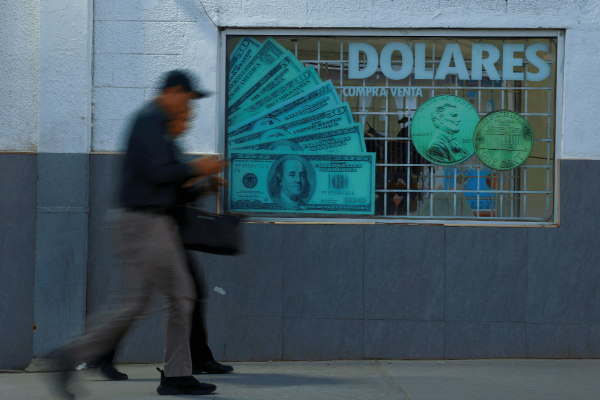ROSTREVOR, Northern Ireland—The most powerful moment in the new Mister Rogers’ biopic A Beautiful Day in the Neighborhood, is when, for a full minute (60 actual seconds, I timed it), nothing happens.
In the scene leading up to the moment in question, Fred Rogers (played with winsome virtuosity by Tom Hanks) and Lloyd Vogel (the character played by Welsh actor Matthew Rhys and based on journalist Tom Junod, whose 1998 Esquire profile of Rogers was the catalyst for the film) are sitting in a Chinese restaurant in downtown Pittsburgh.
Vogel is in crisis. Existential, relational, spiritual, mid-life. All of the above. It’s fueled in no small part by his estranged relationship with his alcoholic, abusive, often-absent father (played by the brilliant Chris Cooper) who has walked back into Vogel’s life just as his own is coming to an end.
Over lunch, where we discover that Mr. Rogers is a lifelong vegetarian — “I just cannot imagine eating anything that has a mother,” he explains — Vogel says he believes his dining companion likes “people like me … broken people.” Rogers is having none of it.
“I don’t think you are broken,” Rogers begins, speaking slowly and deliberately. “I know you are a man of conviction, a person who knows the difference between what is wrong and what is right. Try to remember that your relationship with your father also helped to shape those parts. He helped you become what you are.”
image2.jpg
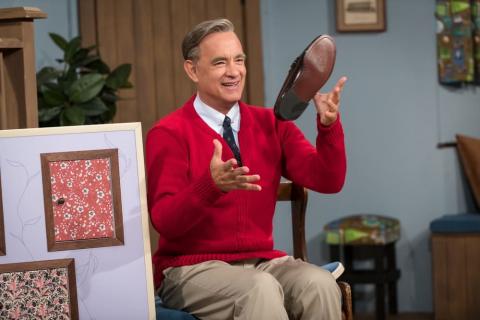
Then Rogers asks his struggling friend to join him in what is essentially a contemplative exercise.
“We’ll just take a minute and think about all the people who loved us into being,” Rogers gently suggests.
“I can’t do that,” Vogel responds.
“They will come to you,” Rogers assures him. “Just one minute of silence.”
The camera slowly pans the restaurant, where we briefly glimpse Rogers’ real-life widow, Joanne, sitting at a nearby table. After a few moments, the lens comes to rest on Hanks’ face. He turns his gaze ever so slightly until he is looking straight at the camera, at us.
A full minute goes by when no words are spoken. It is profoundly affecting.
Finally, Vogel exhales.
“Thank you for doing it with me,” Rogers says. “I feel so much better.”
I did, too.
As I watched an online screener of the movie with my husband in our living room last month, I imagined theaters full of people exhaling in unison, perhaps unaware they had participated in a minute of mindfulness, a meditation.
I love that Rogers doesn’t ask Vogel (or the audience) to be grateful for or to the people who come to mind in those 60 seconds. He simply asks us to be open to whoever comes. Without judging them or ourselves.
Mr. Rogers’ and his meditation came to my mind this morning as I hiked a steep, two-mile path through the forest to the Cloughmore Stone — An Chloch Mhór in Irish, meaning “The Big Stone.” It’s a massive granite boulder that sits in a clearing about 1,000 feet above the village where I’ve been staying since completing a 200-mile walk along the border between Northern Ireland and the Republic of Ireland with a small group of peace activists last week.
img_5117.jpg
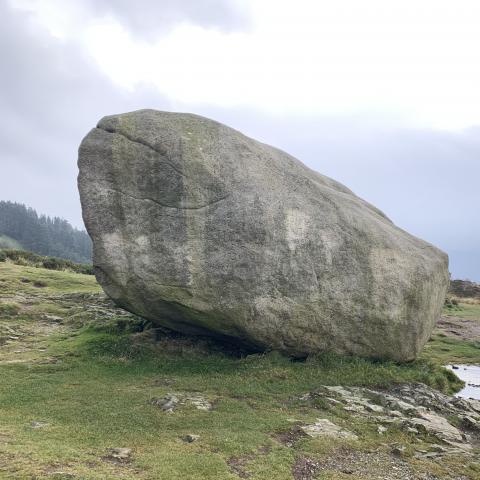
Photo by Cathleen Falsani
The Big Stone, which, depending on who you talk to, was deposited here by a glacier 10,000 years ago or was tossed here from the Cooley Mountains on the other side of Carlingford Lough by the mythical Irish warrior Fionn mac Cumhaill, is also believed to have been the inspiration for Aslan’s table in C.S. Lewis’ Narnia stories.
“That part of Rostrevor which overlooks Carlingford Lough is my idea of Narnia,” Lewis, who spent part of his childhood in Rostrevor, once wrote in a letter to his elder brother, Warren. The landscape here makes it seem possible that a giant might come bounding over a hillock or that you’ll find Mr. Tumnus playing the pan flute next to the narrow river that flows through the Fairy Glen, so named for the “little people” who live along its banks, according to local lore. (It’s an actual place; I can see it from my rental cottage, though I haven’t spotted any fairies. Yet.)
“How I long to break into a world where such things were true,” Lewis said of his Narnia and the actual geographic place that inspired it.
Throughout his life, Lewis often returned to this idyllic village nestled between the Mourne mountains and the lough, a glacial fjord that forms part of the border between the North and the Republic. Climbing the steep mountain paths toward the Big Stone, I pictured young Jack Lewis rambling through this land, imagining mythical creatures and creating stories that would someday shape the imaginations of countless other children, including mine.
Standing next to the massive stone, the wind howling and temperature dropping, I could almost hear Mr. Beaver answering Susan’s question about whether Aslan is “safe:”
"Who said anything about safe? 'Course he isn't safe. But he's good.”
As I schlepped up the mountainside and on the much easier descent an hour later, I practiced Mr. Roger’s contemplative exercise from the new movie, letting my mind wander to the people who have loved me into the person I am today.
There were dozens of names and faces. Family (biological and chosen), friends, teachers, professors, pastors, priests, rabbis, yogis, musicians, writers, artists, and even the odd face of a stranger whose name I never learned but whose love left its mark on me all the same.
The person who came most often to my mind, however, was the woman whose ashes I am wearing in a locket around my neck: My mother, Helen, who passed away in August.
Before I could read them on my own, my mother read me fairy tales, fables, and Dr. Seuss’s whimsical rhyming stories, and later pressed a boxed set of Lewis’ seven Chronicles of Narnia into my hand.
mom_and_cathleen_1972.jpg
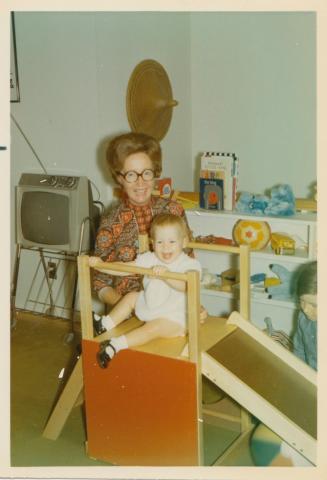
Photo courtesy Cathleen Falsani
She introduced me to Mr. Rogers on our black-and-white living room TV set as a child in the 1970s. One of Mom’s graduate degrees focused on early childhood development and she understood what Rogers was trying to do through the show, which is why she preferred Mr. Rogers Neighborhood to Captain Kangaroo, School House Rock, and even Davey and Goliath.
I recently rediscovered a tape recording of her “interviewing” a 3-year-old me for one of her graduate classes about my feelings after having been gently disciplined by my father, whom I adored. She listened (actively), mirrored what she heard back to me, and affirmed that what I was feeling was OK. Just like Mr. Rogers did on the show.
In his Neighborhood of Make-Believe, with simple hand puppets with complex internal lives such as Daniel Striped Tiger, Prince Tuesday, and Ana Platypus, he did something profound. Rogers and his collaborators on the show listened intently to children, created routine and a safe, sometimes magical place where they might be understood, affirmed, and cherished.
For those of us who perhaps didn’t always get the emotional support we needed at home, it was a gift that helped shape who we are as adults, parents, and grandparents.
My mother was Irish — my grandmother, Nellie, who died when my mother was just 4 years old, left her village not too far from here in 1920 before there was a border between the North and the South. A year before she died, I brought Mom to Ireland for the first time and we saw a lot of this storied island, though we never made it to Rostrevor. She would have loved this place and I’m hoping she got a kick out of tagging along in the locket as we trod through the troubled and thin places of the borderlands at 3 MPH. Richard Rohr might have dubbed it a walking meditation for its “holy goallessness.”
mom_in_ireland_2018.jpg
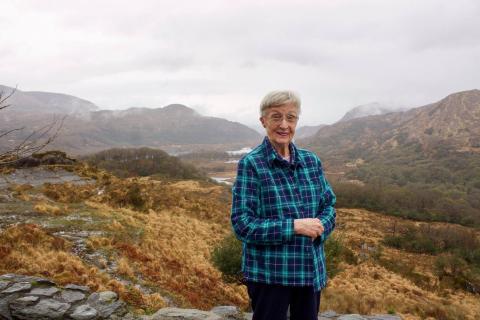
Photo by Cathleen Falsani
The thought of it makes me smile. And yet, like Vogel and his father, our relationship was profoundly complicated. For much of my life, my mother was my fiercest critic and chief antagonist. We fought nearly to the bitter end, but made our peace before she left this side of the veil. Thanks be to the God Who Listens.
Junod says his real-life relationship with his father was fraught but not as dramatic as the Vogels’ volatile, sometimes violent rapport in the film. (Poetic license was taken with the facts of Junod’s story for dramatic effect in the film on several occasions, which in part was why the decision was made to change the character’s name for the film, Junod told me recently.)
Junod and Rogers (who really was a vegetarian) did in fact have lunch in Pittsburgh, but it was at an Indian restaurant and there was no minute of silence — although that was something Rogers was known to do often with people, Junod said.
Rogers saw Junod’s woundedness and reached out with an “ear of grace,” as he did with so many others, he said. “Fred never told me what to do or how to do it, but I absorbed so much from him without him having to say a word.”
A Beautiful Day in the Neighborhood, which opens in theaters nationwide today, makes a point of not descending into hagiography as perhaps other projects celebrating Fred Rogers have. He was a real person with real faults and real feelings who made an extraordinary impact on the world through great effort, discipline, faith, and collaboration with others.
Early on in the film, Vogel asks Mrs. Rogers (played by Maryann Plunkett) what it’s like being married to a “living saint.” She balks at the suggestion.
“I’m not fond of that term,” she says, kindly but firmly. “If you think of him as a saint, then his way of being is unattainable. He works at it all the time. It’s a practice. He’s not a perfect person.”
To me, the power of the film and Rogers’ legacy lies in the tools and practices they offer us for how to be more present, connected, and loving people. How to be both safe and good.
Got something to say about what you're reading? We value your feedback!






